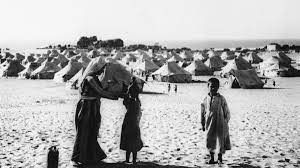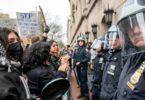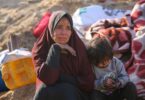Zarefah Baroud
On this day 76 years ago, my ancestral village Beit Daras, located in the northern Gaza district of Palestine, then under the British mandate, was attacked by Jewish militias. The Nakba, or the Zionist ethnic cleansing of Palestine, had already begun. The systematic torment, brutalisation and killing of Palestinians by Zionist militias, aimed at establishing a Jewish ethno-state in historical Palestine, would result in the expulsion of at least 750,000 Palestinians.
As I watch the genocide unfold in Gaza today, I cannot help but reflect on the fate of my village and my ancestors. Just as my grandparents were expelled from their village as children, their descendants are experiencing the same trauma, as they face displacement, injury and death at the hands of the same genocidal Zionist project.
Much of what I know about Beit Daras comes from my father, Ramzy Baroud, who dedicated many years to researching and chronicling the history of our family and of Beit Daras. The grounds of our village had been populated for centuries and had witnessed the rise and fall of various empires and the rule of various conquerors – from the Romans to the Crusaders, to the Mamluks, and the Ottomans. Its long history was imprinted on this quaint community, which in 1948 had a population of 3,190 indigenous Palestinians.
Beit Daras was home to my great grandparents, Zainab and Mohammed, my grandfather Mohammed’s parents. It was also home to Mariam and Mohammed, my grandmother Zarefah’s parents. Zainab and Mohammed lived off their farm, where they grew fruits and grains. Mohammed was also a skilled basket weaver and would often travel to the Palestinian port city of Yaffa to sell his baskets at the bustling old markets.
Mariam and Mohammed were also farmers and made a living from their land. Both of these families had their roots in Beit Daras. On March 27, the Haganah Zionist militia attacked the village with mortar fire from the neighbouring Zionist colony Tabiyya, killing nine villagers and burning crops. The horror stories of the Nakba had already reached Beit Daras and residents were mobilising to protect their community. They raised money to buy rifles, with many women selling their gold to support the resistance efforts. The small Beit Daras force was no match for the well-equipped, British-trained Jewish militia, but they nevertheless held their ground for almost two months. “The men fought like lions,” Um Adel, who was just a young girl during the Nakba, told my father.
In mid-May, the Haganah surrounded the village, bombarding it indiscriminately. This was the final battle for Beit Daras. Um Mohammed, who survived the onslaught described the scene to my father: “The town was under bombardment, and it was surrounded from all directions. There was no way out. They surrounded it all, from the direction of Isdud, al-Sawafir and everywhere. We wanted to pursue a way out. The armed men [the Beit Daras fighters] said they were going to check on the road to Isdud, to see if it was open.” The fighters came back from scouting the road and said a passage had opened for women and children to escape. But that passage was a trap.
“The Jews let the people get out, and then they whipped them with bombs and machine guns. More people fell than those who were able to run. My sister and I … started running through the fields; we’d fall and get up. My sister and I escaped together holding each other’s hand. The people who took the main road were either killed or injured, and those who went through the fields. The firing was falling on the people like sand,” Um Mohammed recalled. David Ben-Gurion, the head of the Jewish Agency at that time, wrote in his diary that Zionist forces had massacred at least 50 Palestinians that day. The villagers who were not killed, were expelled. On the eve of their expulsion, Zainab and Mohammed collected a few necessities, preparing their family donkey for the trek. They bid what they did not know would be a final farewell to their precious house which they had built themselves.
Mariam and Mohammad also prepared to leave. Mohammad had taken up arms to defend the village and Mariam had refused to leave without him. The pain of failing to stop the Zionist militias weighed heavy on Mohammed, who gradually fell ill, as he and his family made their way out of Beit Daras – he and Mariam walking and his children, including two-year-old Zarefah, riding atop the donkey. Dodging Zionist militias’ mortar and sniper fire, the two families made it to what is now called the Gaza Strip, their feet bloodied from the long walk. They were no longer residents of Beit Daras; they had become refugees in Gaza’s Bureij and Nuseirat camps, with nothing to their name. On top of their irreplaceable loss, upon pitching their tent in Gaza, Mohammed, Zarefah’s father fell into a coma, dying shortly after. He left my great-grandmother Mariam, who refused to remarry and took care of her children by herself.
While my grandparents, Zarefah and Mohammed, were laid to rest many years ago, much of the Baroud family remained in Gaza, being forbidden by the Zionist entity from returning to their ancestral village, but spending their lives dreaming of the day Palestine would be liberated, and they would return home. This piece of paradise that they were forced to leave behind, adorned with green rolling hills and pastures, vineyards and fragrant citrus groves and almond orchards, would become but a fantasy for the us, the young generation. Seven decades after Beit Daras’s Nakba, the descendants of its original residents are facing another one. For nearly six months now, Israel has been waging a genocidal campaign intended to “finish the job” it had started in 1948.
Since October 7, many of these descendants have been slaughtered in Israeli bombardment and ground invasions. As we solemnly remember the attacks that ethnically cleansed Beit Daras 76 years ago, we mourn the members of our family who have been recently killed, from young children, to mothers and fathers, to treasured members of the Nakba generation who held to the hope of their return until the end. Amid brutal Israeli bombardments and invasions, Zarefah’s own daughter, my aunt, has lived through her mother’s experience, being forced to flee from her home in Qarrara along with her children with little more than their clothes on their backs. The story of the Baroud family is not unique. Approximately 80 percent of Gaza’s population consists of refugees from the Nakba, the majority of them made refugees once again by the US-backed Israeli-executed genocide.
The Nuseirat and Bureij camps where my grandparents had spent their childhoods, fell in love, and raised their families, were largely decimated. And just as the people of Beit Daras resisted, the people of Gaza today have also risen up against this attempted Zionist settler conquest. As we witness the genocide unfolding in Gaza, our ancestors’ lived experiences of the Nakba feel that much closer. Seventy-six years later, we face the imminent threat of colonial erasure just as they did all those years ago. While we mourn the loss of many members of our family, our commitment and dedication to our grandparents’ dream of returning home grows infinitely stronger. Though Beit Daras has remained uninhabited since our last Palestinian warrior fell, the remnants of its homes, and two lone pillars of the Grand Mosque where my grandfather used to pray as a boy remain, eagerly awaiting our return.
When that sweet reunion finally takes place, we will rebuild Beit Daras’s masjid with its original white pillars, resurrect its houses, and replant its orchards and fields with its native trees and crops. Though the lives of so many Beit Daras villagers and their children and grandchildren were violently taken, we will embed their spirit in every mud brick that is laid, as we rebuild the village.
Aljazeera







